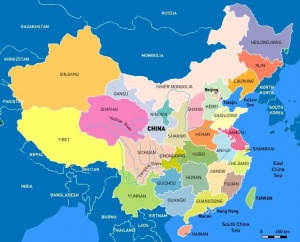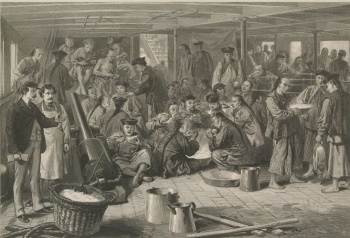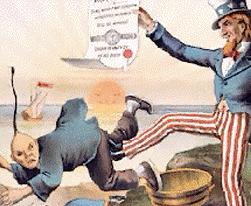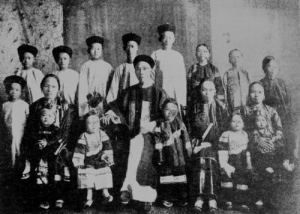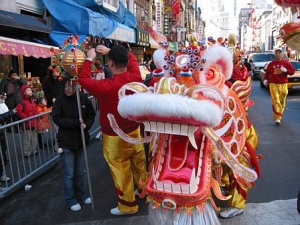From The Peopling of New York City
Introduction
China, located in southeast Asia, is the third largest country in the world. The land mass is 3,704,427 square miles, which is as big as all of Europe. There are over a billion people in the People's Republic of China today, ninety-four percent of which are Han Chinese. The other six percent is composed of fifty-five non-Han minorities.[1]The official language of China is Mandarin (Guanhua), spoken by over seventy percent of the Han Chinese. The other Chinese, mostly from southern China, speak the other seven major Chinese dialects: Wu, Xiang, Gan, Northern Min, Southern Min, Yue (Cantonese), and Kejia (Hakka). The official writing system is Simplified Chinese.
The motivations behind Chinese immigration to the United States were, in many ways, similar to those of most immigrants. They sought better economic opportunity, or left China as contract laborers or refugees. However, as a racial minority, their experience differs very much compared to European immigrant group and other racial minorities.
Chinese immigrants, unlike other immigrants, were singled out by laws enacted by states within the U.S. in which they lived. They were the first immigrant group to be targeted for exclusion and denied citizenship. Throughout the years, despite the harsh conditions they faced, the Chinese were able to find a place in the United States and contribute to the nation's culture, politics, and other areas. More specifically, from their steady immigration to New York City, the famous Chinatown of lower Manhattan was formed and continues to develop to this day.
History
The earliest identifiable Chinese immigrants in New York City dates from 1808. Many of them were seamen, and since few of the early Chinese seamen ventured far from the docks of lower Manhattan, the earliest opportunity for other New Yorkers to see someone from China was in variety houses or on stage. A Chinese person in the United States was called "John Chinaman" or simply "John."The Chinese were called clannish, dangerous, criminal, opium sodden, cowardly, callous, debased and servile, etc., and their Chinatowns were "unsanitary quarters," "full of prostitution and gambling." [2]
But from the continued immigration of Chinese people to New York City, the well-known Chinatown, in lower Manhattan, was formed and continues to develop to this day. As the city changed, its peoples changed and adapted, and the Chinese were able to make a place for themselves despite the very harsh conditions they faced.
Click for further information on the Chinese!
Class
Once the Chinese arrived in the United States, they faced a multitude of problems establishing themselves as a community. Whether it was the Chinese Exclusion Act that restricted Chinese growth, or the low ratio of women to men; the Chinese community had to rely upon their fellow man to get somewhere. In this section we explore what happened to the Chinese after they came to New York.
A common problem faced by immigrants first arriving anywhere, let alone New York, is the area in which they will live. In the section Residential Patterns we discuss how Chinatown grew out of nothing. The Occupational and Educational Patterns sections talk about what the Chinese men do for a living, and economy and percentage of wages are covered in Income. Additionally, one of the most crucial impacts on immigrants is their health. The health section discusses how Chinese-Americans view health as opposed to Western beliefs.
- Residential Patterns of Chinese Immigrants to New York
- Occupational Patterns of Chinese Immigrants to New York
- Educational Patterns of Chinese Immigrants to New York
- Income of New York's Chinese Immigrants
- Health of New York's Chinese Immigrants
Culture
Once immigrants have moved to a new place, they start to form communities. In these communities, they create a mix of old culture and new culture. The old culture is custom that is in their blood, that is engraved in them from their motherland. On the other hand, the new culture may include sacrifices they have to make due to the difference in region. How did they live once they moved to Chinatown? How did the ratio of men to women affect them? How did business interactions go? Were they mostly with other Chinese people or were foreigners involved? Did these foreigners treat them well, or with respect?
To understand the differences in lifestyle between the Chinese homeland culture and the Chinese culture that developed in New York City, here we take a look into the roots and origins of the immigrants and the way of life they developed in New York.
- Chinese Immigrant Family Structures
- Religious Practices of Chinese Immigrants
- Chinese Immigrants and Language
- Chinese Immigrant Entertainment
- Chinese Immigrants and Assimilation
The Bigger Picture
Once the Chinese immigrants were assimilated into New York City, what contributions did they make? Did they help build the city? Make it prosper? Worsen it? How did the city effect them and how did they effect the city? The Irish have their St. Patrick's Day. Did the Chinese have such an commemoration of their culture? What about art and music? Did they bring that from China and how did it blend with the New York atmosphere? Here, we examine the contributions of Chinese immigrants on the United States, focusing on crime, politics, and culture.
- Chinese Immigrants and National and Global Events
- Chinese Immigrants and Crime
- Chinese Immigrants and Politics
- The Cultural Contributions of Chinese Immigrants
References
- ↑ http://www.everyculture.com/multi/Bu-Dr/Chinese-Americans.html
- ↑ Bonner, Arthur. Alas! What Brought Thee Hither?. Illustrated Edition. Fairleigh Dickinson University Press, 1996. Print.
